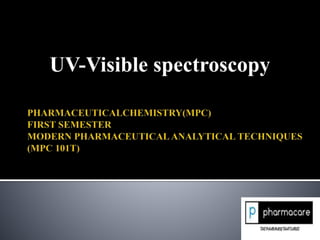
PHARMACEUTICALCHEMISTRY(MPC).pptx
- 2. What is Spectroscopy? What is UV-Vis Spectroscopy? What is the main purpose of UV spectroscopy? Which solvent is used in UV spectroscopy? Principle of UV-Visible Spectroscopy Choice of solvents and solvent effect Difference/ derivative spectroscopy Applications of UV Visible spectroscopy
- 3. Spectroscopy is a technique that is used to study the interaction of matter and electromagnetic radiation. It involves the measurement of the energy absorbed or emitted by a sample at different wavelengths. Spectroscopy can be used to identify the composition of a sample, to study the physical and chemical properties of a sample, and to determine the structure of a molecule
- 4. UV spectroscopy, also known as UV-visible spectrum (UV- Vis also known as UV/Vis). UV-Vis spectroscopy is a technique used to measure the absorption of ultraviolet (UV) and visible light by a sample. It is commonly used to determine the concentration of a substance in a solution or to identify the functional groups present in a molecule. The absorption of light by a sample is measured at different wavelengths, and the resulting data is plotted as a spectrum. The absorption spectrum can be used to identify the presence of specific functional groups or to determine the concentration of a substance in a solution.
- 5. The main purpose of UV spectroscopy is to determine the absorption or transmission characteristics of a sample in the ultraviolet (UV) region of the electromagnetic spectrum. By measuring the amount of light absorbed by a sample at different wavelengths, researchers can learn about its chemical composition, electronic structure, and other properties. UV spectroscopy is used in a wide range of applications, including: Identifying and quantifying the concentration of a specific compound in a mixture Characterizing the purity of a sample Determining the electronic structure of a compound, such as the presence of conjugated double bonds or aromatic ring systems Studying chemical reactions and reaction kinetics Analysis of biological macromolecules like proteins, DNA, and RNA Environmental analysis Pharmaceuticals and drug analysis
- 6. The solvent used in UV spectroscopy depends on the nature of the sample being analyzed and the specific application. Some common solvents used in UV spectroscopy include: Water: Water is often used as a solvent for UV spectroscopy of polar compounds, such as acids, bases, and biomolecules. Alcohols: Alcohols like methanol and ethanol are commonly used as solvents for UV spectroscopy of organic compounds. Acetonitrile: Acetonitrile is a polar, aprotic solvent that is often used for UV spectroscopy of polar compounds and for samples that are not soluble in water or alcohols. Dichloromethane: Dichloromethane (DCM) is a non-polar solvent that is often used for UV spectroscopy of non-polar compounds. Hexane: Hexane is also a non-polar solvent that is often used for UV spectroscopy of non-polar compounds
- 7. The Principle of UV-Visible Spectroscopy is based on the absorption of ultraviolet light or visible light by chemical compounds, which results in the production of distinct spectra. Spectroscopy is based on the interaction between light and matter. When the matter absorbs the light, it undergoes excitation and de-excitation, resulting in the production of a spectrum.
- 8. As per the Beer-Lambert law, the greater the number of absorbing molecules (that have the ability to absorb light of a specific wavelength), the greater the extent of absorption of the radiation.
- 9. The photomultiplier tube is the extensively used detector in UV-Vis instruments. It includes a photoemissive cathode (electrons are emitted from the cathode when photons strike it), several dynodes (a dynode emits multiple electrons when one electron strikes it) and an anode. The UV-Vis spectrum can by recorded via the following types of absorbance instruments: a. Single beam spectrometer b. Double beam spectrometer c. Simultaneous spectrometer
- 10. The absorption bands in ultraviolet spectrum are very broad as compared with infrared or NMR spectrum. Ultraviolet spectra of compounds are usually determined either in the vapour phase or in very dilute solution. Solvent must be transparent with in the wavelength range being examined. It should not itself absorb radiation in the region under investigationIt should be less polar, to minimum interaction with solute molecule Spectrascopic (Analytical) grade solvents should be used.The most commonly used solvent is 95% ethanol. It Is a cheap Good dissolving power Does not absorb radiation above 210nm Some other solvents which are transparent above 210 nm.Eg: n- hexane, cyclohexane, methanol, water and ether
- 11. DNA & RNA analysis Pharmaceutical analysis Bacterial culture Beverage analysis Characterization of smaller nanoparticles. Examination of structural protein changes by tracking changes in peak wavelength absorbance. Determination of battery composition Kinetic and monitoring studies of dyes and dye byproducts Absorbance of hemoglobin for the determination of concentration of hemoglobin in cancer research Measuring color index to monitor transformer oil Determination of concentration of proteins through direct measurement or colorimetric assays Study of enzymatic reactions Monitoring growth curve of bacterial cell suspensions Can be used as a detector for HPLC Quality control. Cosmetic industry. Petrochemistry. Pharmaceutical research. Optical components. Food and agriculture. Life sciences. Traditional chemistry.
- 12. Derivative spectroscopy another simplest method for an increasing a selectivity is derivatisation of spectra. This operation allows to remove spectral interferences and as a consequence leads to increase selectivity of assay It involves the conversion of a normalspectrum to it's first, second or higher derivative spectrum The normal absorption spectrum is reffered to as the fundamental zero order or spectrum.
- 13. The selectivity and accuracy of spectrophotometric analysis of sample containing absorbing interference may be markedly improved by the technique of difference spectrophotometry. FEATURE OF DIFFERENCE SPECTROPHOTOMETY:- The measured value is the difference absorbance(AA) between two equimolar solutions of the analyte in different chemical forms which exhibit spectral characteristics.
- 14. Thank you